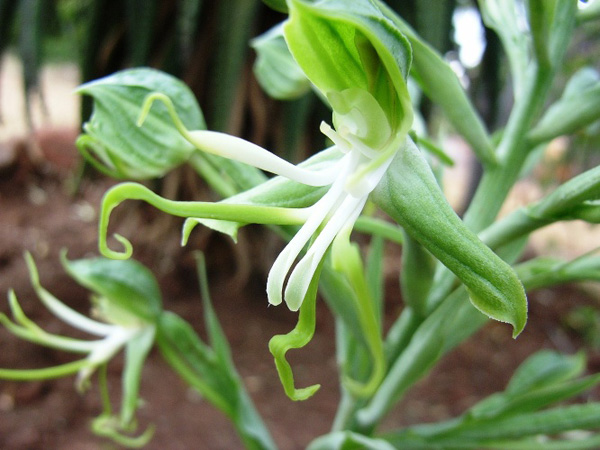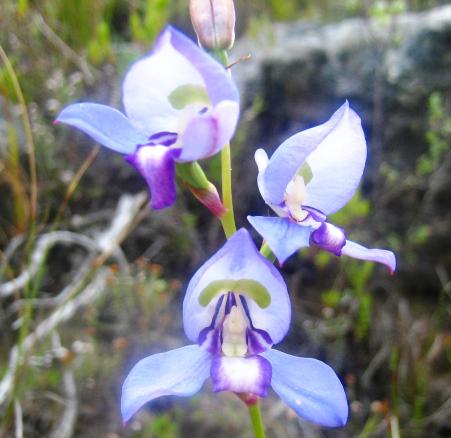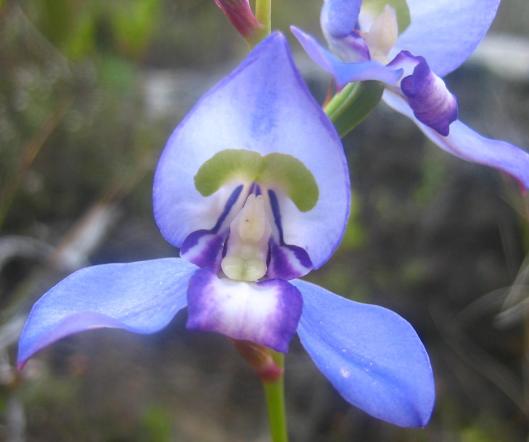- Hits: 8872
Orchids
|
Botanical name |
Bonatea antennifera |
|
Other names |
Bonatea speciosa, var. antennifera |
|
Family |
Orchidaceae |
|
Dimensions |
Terrestrial orchid with green and white flowers, sometimes over 50 cm in height; dormant in winter |
|
Description of stem |
Erect light green flower stalk with decreasing leaf size upwards |
|
Description of leaves |
Grey-green leaves that encircle the stem and taper to a sharp point, mildly undulating |
|
Description of flowers |
Green and white flowers on the single stem forms the atteactive inflorescence that sometimes topples when many flowers are produced; the top sepal is a pointed hood over the protruding other flower parts, dominated by two green, curved sepals, long white terete petals and a dangling lip |
|
Description of seed/fruit |
|
|
Description of roots |
Flat, elongated tuber |
|
Variation |
Seems to be very stable in form and appearance? |
|
Propagation and cultivation |
Tuberoids can be planted in pots in a suitable orchid mix, 2 cm below the surface; water only during the growing season, about August when new growth appears; repot every 5 years; semi-shade |
|
Tolerances |
|
|
Uses |
Garden plant |
|
Ecological rarity |
Not threatened |
|
Pests and diseases |
Little seems to affect the plants in habitat (observed in the Magaliesberg) |
|
Other |
Closely related to B. speciosa; there are over 20 species in the Bonatea genus, many of which occur in southern and tropical Africa |
|
Location |
Grows in semi-shade under trees and shrubs in drier environments, often in thorn savannah |
|
Distribution |
Gauteng, Northwest, Mpumalanga and Northern Cape provinces |
|
Country |
South Africa; Zimbabwe |

- Hits: 4722
|
Botanical name |
Disa graminiflora |
|
Other names |
Blue disa, previously Herschelianthe graminiflora |
|
Family |
Orchidaceae |
|
Dimensions |
A small perennial, reappearing annually after a dormant period from a tuberous rootstock |
|
Description of stem |
|
|
Description of leaves |
Narrow leaves from the base, semi-erect |
|
Description of flowers |
Racemes of blue flowers appearing in summer; light blue sepals, the dorsal one darker blue towards the apex, pointed rather than hooded; the lip white at the centre, bright to dark blue at the edges, recurving, comparatively big; the pollinia in front of the dorsal sepal as two greenish yellow protuberances drooping sideways above the dark blue petals; the stigma white, central |
|
Desciption of seed/fruit |
|
|
Description of roots |
Tuberoids, growing shoots that form new root tubers |
|
Variation |
Some flower colour variation |
|
Propagation and cultivation |
Can be grown from seed, germination slow; humidity and temperature controlled in greenhouse conditions; Disa Society at +27 (0)21 913 6902 or |
|
Tolerances |
Can withstand summer heat, provided that the roots remain moist |
|
Uses |
A delightful sighting in nature; plants may not be removed; a rare garden subject, grown from seed in special, carefully controlled circumstances |
|
Ecological rarity |
Very small areas that provide the required conditions of the natural habitat |
|
Pests and diseases |
|
|
Other |
The Orchid Conservation Alliance creates orchid habitat reserves in the Equadorian Andes, See www.orchidconservationalliance.org ; on www.orchidspecies.com over 6000 orchid species in 611 genera are listed; a natural hybrid occurs between D. graminiflora and D. ferruginea, called D. vogelpoelii; blue disas include D. hians, lonicornu and maculata; find blue disa photos on www.disas.com/louis_vogelpoel_02.htm for blue disa pictures |
|
Location |
Grows in cool, wet fynbos areas close to rivers, often in wet moss near waterfalls; may appear in endemic areas after veld fires |
|
Distribution (SA provinces) |
Western Cape |
|
Country |
South Africa |


- Hits: 10107

